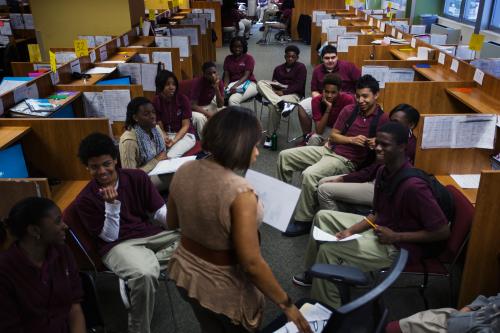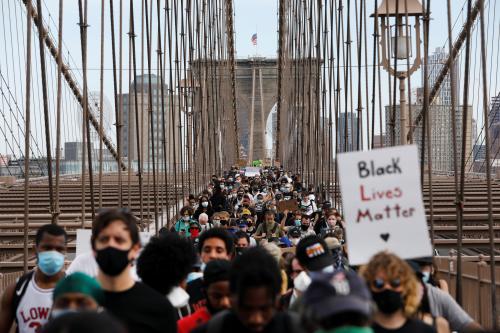When we think about anti-Black bias in relation to schools, it is easy to begin with teachers. For starters, teachers are just as biased as everyone else. And as the primary contact for students in school, any anti-Black sentiments they have can have direct impacts on Black students’ academic engagement and success. More still, teachers have been shown to be promising recipients of low-cost, bias-prevention interventions. In many respects, focusing on understanding and reducing the anti-Black bias of teachers makes sense.
But if there is anything we have learned during the last few weeks of mass protests against police brutality that have erupted in city streets, in the United States and abroad, it’s that anti-Black bias is societal, endemic, and far-reaching—a scourge that seeps into the structure of our institutions and threatens the vitality of our democracy. For educators, policymakers, and researchers interested in how anti-Black bias relates to schooling, a narrow focus on teachers, though important in its own right, may miss a lot of the action.
Rather, what might we learn about the nature of educational inequality if we examine anti-Blackness as a quality of communities? It’s communities, after all, who determine how educational resources are distributed, the elected officials and volunteer groups who set educational priorities, the formation and gerrymandering of district boundaries and school attendance zones, and the school leadership that presides over the operation of school life. In theory, anti-Black bias can infect them all.
Thinking about and studying racial bias at this scale is undoubtedly complex, doubly so for quantitative social scientists interested in educational matters who have lacked good data to talk about anti-Black bias as a community-level phenomenon. But recent advancements in data quality, coverage, and access do allow for some compelling new insights.
In a recent study, I examined the relationship between anti-Black bias, measured at the county level based on a broad cross-section of community residents, and Black-white test score gaps. In particular, I used data on anti-Black bias from a national survey of over 1 million respondents from across the United States who completed an online version of the Race Implicit Association Test and achievement data from the Education Opportunity Project covering over 300 million test scores of U.S. schoolchildren.
I found that counties with higher levels of racial bias had larger Black-white test score disparities, a pattern driven by decreased achievement of Black students rather than increased achievement of white students. This overall relationship held even after adjusting for a host of observable differences across counties, including Black-white differences in socio-economic status, crime rates, and levels of residential segregation.
In practical terms, the magnitude of this association is on par with other widely accepted predictors of racial test score gaps. Knowing how much anti-Black bias exists in communities tells us just as much about the Black-white test score gap as knowing the racial gap in family income or the Black-white difference in rates of single parenthood, and about half as much as knowing the Black-white gap in household educational attainment.
Surprisingly, Black-white disparities in educational inputs do not appear to be the channel through which anti-Black bias translates into achievement gaps. In particular, very little of the association between anti-Black bias and test score gaps was explained by Black-white disparities in per-pupil expenditures or Black-white gaps in access to early childhood programming.
It turned out that sorting mechanisms were the primary culprit. Between-school segregation explained about one-third of the adjusted association between anti-Black bias and achievement disparities. Black-white gaps in gifted and talented assignments accounted for about two-thirds of the adjusted association, and Black-white gaps in special education placement accounted for basically all of it. In other words, anti-Black bias is related to test score disparities because of how students are sorted and labeled in schools.
These emerging findings, along with others, suggest that educational inequality may be worse in places where there is more bias in the air, aside from any racist beliefs on the part of school teachers. Although these findings are correlational and the normal caveats about causality apply, results are consistent with the idea that collective rates of anti-Black bias may affect educational opportunity through sorting mechanisms that operate both within and beyond schools.
Therefore, if Americans are serious about addressing the role that anti-Black bias plays in the U.S. educational system, efforts to reduce the biases of individual teachers are not enough. Rather, doing so will require a progressive social movement of educators, policymakers, researchers, and other educational stakeholders organized around the idea that anti-Blackness, as a disease for which there is no cure on the market, requires that anti-racism be institutionalized in educational policy and practice.
A variety of anti-racist initiatives should be advanced as part of a wholesale assault on anti-Blackness in our schools. These could include such things as Title-IX-inspired policies requiring that Black and white students in the same district have equal access to advanced coursework, including pathways to calculus, International Baccalaureate programs, and Advanced Placement classes; the abolition of “carceral pedagogies” that criminalize curiosity and pressure teachers to prioritize Black children’s compliance over their engagement; adopting restorative justice practices that keep Black children learning in classrooms and show promise at reducing discipline disparities; the elimination of gifted and talented programs, or, short of that, universal screening based on holistic evaluations to ensure that gifted and talented Black children get a fair shot at being identified as such; requiring school counselors and teachers to be trained in the racial contours of trauma-informed practice; the removal of school resource officers who contribute little to violence reduction and view Black children as threats; the adoption of ethnic studies programs and culturally responsive teaching practices that center the experience of Black people in the curriculum and increase Black children’s civic engagement and success in school; the creation of accountability standards, third-party audits, and annual reassessments around special education placements to increase the likelihood that Black children misidentified as special needs can be reintegrated into general education classrooms; and innovative school desegregation plans that make it harder for racist white families to hoard resources.
Surely efforts to reduce teacher bias should continue. But we must move toward an educational system where anti-Black bias suffocates under the weight of targeted, anti-racist policies designed to countervail the full spectrum of insidious, discretionary tendencies—on the part of teachers and community members alike—that devalue Black life.





Commentary
Anti-Blackness and the way forward for K-12 schooling
July 1, 2020